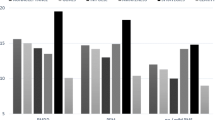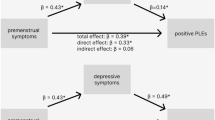Abstract
Objectives
The present study aims to assess the factor structure of the DSM–IV Premenstrual Dysphoric Disorder (PMDD) symptoms and its relationship with depressive symptoms.
Methods
We evaluated retrospectively PMDD symptoms in 513 female college students, through a self–reporting questionnaire based on DSM–IV criteria, in addition to the Beck Depression Inventory (BDI). Principal component analysis on PMDD symptom data was performed to assess its dimensional structure.
Results
In this non–clinical sample, the analysis indicated a higher importance of the dysphoric dimension, but physical symptoms as well as “being out of control” or “overwhelmed” should also be viewed as major symptoms of PMDD. Behavioural symptoms are of secondary importance. The mean BDI score of PMDD group was significantly higher (p < 0.05) than non– PMDD group.
Conclusion
The factor structure of the total sample was similar to the symptom structure suggested by DSM–IV diagnostic criteria. Depressive symptoms should be viewed as a confounding variable in PMDD.
Similar content being viewed by others
References
Allen SS, McBride CM, Pirie PL (1991) The shortened premenstrual assessment form. J Reprod Medicine 38(11):769–772
Alvir JM, Thys-Jacobs S (1991) Premenstrual and menstrual symptom clusters and response to calcium treatment. Psychopharmacol Bull 27(2):145–148
American Psychiatric Association (1994) Diagnostic and statistical manual of mental disorder, fourth edition, appendix B, Washington DC, American Psychiatry Press
Angst J, Sellaro R, Stolar M, Merikangas KR, Endicott J (2001) The epidemiology of perimenstrual psychological symptoms. Acta Psychiatr Scand 104:110–116
Barnhart KT, Freeman EW, Sondheimer SJ (1995) A clinician guide to the premenstrual syndrome. Med Clin North Am 79:1457–1472
Beck AT, Ward CH, Mendelsson M, Mock J, Erbaugh J (1961) An inventory to measure depression. Arch Gen Psychiatry 4:561–571
Beck AT, Steer RA (1984) Internal consistencies of the original and revised Beck Depression Inventory. J Clin Psychol 40:1365–1367
Chaturvedi SK, Chandra PS, Issac MK, Sudarshan CY, Beena MB, Sarmukkadam SB, Rao S,Kaliaperumal VG (1993) Premenstrual experiences: the four profiles and factorial patterns. J Psychosom Obstet Gynaecol 14:223–235
Christensen AP,Oei TPS (1995) Correlates of premenstrual dysphoria in help-seeking women. J Affect Dis 33:47–55
Christensen EM, Larsen JK, Gjerris A (2003) The stability of the Seasonal Pattern Assessment Questionnaire score index over time and the validity compared to classification according to DSM-III-R. J Affect Disord 74:167–172
Condom JT (1993) Investigation of the reliability and factor structure of a questionnaire for assessment of the premenstrual syndrome. J Psychosom Res 37(5):543–551
Cumming DC, Cumming CE, Krausher RJ, Fox EE (1991) Towards a definition of PMS.II: a factor analytic evaluation of premenstrual change in women with symptomatic premenstrual change. J Psychosom Res 35(6):713–720
De la Gándara-Martín JJ, de Diego-Herrero E (1996) Transtorno disfórico premenstrual: un estudio epidemiológico. Actas Luso-Esp Neurol Psiq 24:111–117
Freeman EW, DeRubeis RJ, Rickels K (1996) Reliability and validity of daily diary for premenstrual syndrome. Psychiatr Res 65:97–106
Gehlert S, Chang CH, Hartlage S (1999) Symptom patterns of premenstrual dysphoric disorder as defined in the Diagnostic and Statistical Manual of Mental Disorders-IV. J Women Health 8:75–85
Gorenstein C, Andrade L, Vieira Filho AHG, Tung TC, Artes R (1999) Psychometric properties of the Portuguese version of the Beck Depression Inventory on Brazilian college students. J Clin Psychol 55:553–562
Gorenstein C, Pompéia S, Andrade L (1995) Scores of Brazilian university students on the Beck Depression and the State-trait Anxiety Inventories. Psychol Rep 77:635–641
Greene R, Dalton K (1953) The premenstrual syndrome. Br Med J 1:1007–1014
Hart WG, Coleman GJ, Russel JW (1987) Assessment of premenstrual symptomatology: a re-evaluation of the predictive validity of self-report. J Psychosom Res 30:185–190
Hartlage SA, Arduino KE (2002) Toward the content validity of premenstrual dysphoric disorder: do anger and irritability more than depressed mood represent treatment-seekers’ experiences? Psychol Rep 90:189–202
Hurt SW, Schnurr PP, Severino SK, Freeman EW, Gise LH, Rivera- Tovar A, Steege JF (1992) Late luteal phase dysphoric disorder in 670 women evaluated for premenstrual complaints. Am J Psychiatry 149:525–530
Johnson RA, Wichern DW (2002) Applied Multivariate Statistical Analysis. 5th ed., Upper Saddle River, NJ, Prentice Hall
Keenan PA, Lindamer LA, Jong SKK (1992) Psychological aspects of premenstrual syndrome. II: utility of standardized measures. Psychoneuroendocrinology 17:189–194
Kendall PC, Hollon SD, Beck AT, Hammen CL, Ingram RE (1987) Issues and recommendations regarding use of the Beck Depression Inventory. Cogn Ther Res 11:289–299
Kendler KS, Karkowski LM, Corey LA, Neale MC (1998) Longitudinal population-based twin study of retrospectively reported premenstrual symptoms and lifetime major depression. Am J Psychiatry 155:1234–1240
Landen M, Eriksson E (2003) How does premenstrual dysphoric disorder relate to depression and anxiety disorders? Depress Anxiety 17(3):122–129
Morgan M, Rapkin AJ, D’Eliam L, Reading A, Goldman L (1996) Cognitive function in premenstrual syndrome. Obstet Gynecol 88:961–966
Mortola JF, Girton L, Yen SC (1989) Depressive episodes in premenstrual syndrome. Am J Obstet Gynecol 161:1682–1687
Rivera-Tovar AD, Pilkonis P, Frank E (1992) Symptom patterns in late luteal-phase dysphoric disorder. J Psychopathol Psychol Assess 34:189–199
Rubinow DR, Roy-Byrne P (1984) Premenstrual syndromes: overview from a methodological perspective. Am J Psychiatry 141:163–172
Steiner M, MacDougall M, Brown E (2003) The premenstrual symptoms screening tool (PSST) for clinicians. Arch Women Ment Health 6:203–209
Stout AL, Steege JF (1985) Psychological assessment of women seeking treatment for premenstrual syndrome. J Psychosom Res 6:621–629
Treloar SA, Heath AC, Martin NG (2002) Genetic and environmental influences on premenstrual symptoms in an Australian twin sample. Psychol Med 32:25–38
Tucker JS, Whalen RE (1991) Premenstrual syndrome. Int J Psychiatr Med 21:311–314
Woods NF, Mitchell ES, Lentz M (1999) Premenstrual symptoms: delineating symptom clusters. J Women Health Gend Med 8:1053–1062
Yuk VJ, Jugdutt AV, Cumming CE, Fox EE, Cumming DC (1990) Towards a definition of PMS: analytic evaluation of premenstrual change in non-complaining women. J Psychosom Res 34: 439–446
Author information
Authors and Affiliations
Corresponding author
Rights and permissions
About this article
Cite this article
Teng, CT., Vieira Filho, A.H.G., Artes, R. et al. Premenstrual dysphoric symptoms amongst Brazilian college students: factor structure and methodological appraisal. Eur Arch Psychiatry Clin Neurosci 255, 51–56 (2005). https://doi.org/10.1007/s00406-004-0535-9
Received:
Accepted:
Published:
Issue Date:
DOI: https://doi.org/10.1007/s00406-004-0535-9




